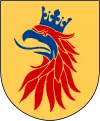斯科訥
斯科讷(又譯斯堪尼亞,瑞典语:)位於瑞典南部斯堪的那維亞半島最南端,為約塔蘭地區之一舊省。斯科讷雖然面積僅占瑞典的3%,但總人口卻達到了1,247,338人[1],相當於瑞典總人口數13%的人口。
| 斯科讷 Skåne | ||
|---|---|---|
| ||
 | ||
| 坐标:55°48′N 13°37′E | ||
| 國家 | ||
| 所屬地區 | 約塔蘭 | |
| 相關省份 | 斯科讷省 | |
| 教區 | 隆德教區 | |
| 面积 | ||
| • 总计 | 11,027 平方公里(4,258 平方英里) | |
| 代表花 | 濱菊 | |
| 代表動物 | 馬鹿 | |
斯科讷的火车轨道非常多,童話小說《尼爾斯騎鵝旅行記》的故事背景也設在斯科讷。
词源
“斯科讷”(Skåne)一词和“斯堪的纳维亚”(Skandinavien)有着共同的词源[2][3][4][5],作为斯堪的纳维亚半岛的最南端,斯科讷在古罗马时期被认为是一个岛屿。其名称可能来自原始日耳曼语词根 *Skaðin-awjo,在后世的古诺尔斯语中为 Skáney[6]。根据一些学者,这一日耳曼词干可重建为*Skaðan-,意思是“危险”或“伤害”(即是英語:、德語:、瑞典語: 的词源)[7]。斯科讷的小镇斯卡讷()有着同样的词干(skan)结合上词缀 -ör, 意思是“沙洲”。
人口發展
據估計,斯科讷於1570年已經有約十一萬人居住。[11] 以下的數字來自兩個不同的來源[12][13]
| 年份 | 人口 | 年份 | 人口 | 年份 | 人口 |
|---|---|---|---|---|---|
| 1620 | 126,000 | 1820 | 312,000 | 1930 | 757,000 |
| 1699 | 142,000 | 1830 | 350,000 | 1940 | 778,000 |
| 1718 | 152,000 | 1840 | 388,000 | 1950 | 843,000 |
| 1735 | 180,000 | 1850 | 443,000 | 1960 | 882,000 |
| 1750 | 197,000 | 1860 | 494,000 | 1970 | 983,000 |
| 1760 | 202,000 | 1870 | 538,000 | 1980 | 1,023,000 |
| 1772 | 216,000 | 1880 | 580,000 | 1990 | 1,068,000 |
| 1780 | 231,000 | 1890 | 591,000 | 2000 | 1,129,000 |
| 1795 | 250,000 | 1900 | 628,000 | 2010 | 1,228,000 |
| 1800 | 259,000 | 1910 | 685,000 | ||
| 1810 | 275,000 | 1920 | 728,000 |
備註及參考資料
- . [2013-07-24]. (原始内容存档于2013-08-17).
- Haugen, Einar (1976). The Scandinavian Languages: An Introduction to Their History. Cambridge, Mass: Harvard University Press, 1976.
- Helle, Knut (2003). "Introduction". The Cambridge History of Scandinavia. Ed. E. I. Kouri et al. Cambridge University Press, 2003. ISBN 978-0-521-47299-9. p. XXII. "The name Scandinavia was used by classical authors in the first centuries of the Christian era to identify Skåne and the mainland further north which they believed to be an island."
- Olwig, Kenneth R. "Introduction: The Nature of Cultural Heritage, and the Culture of Natural Heritage—Northern Perspectives on a Contested Patrimony". International Journal of Heritage Studies, Vol. 11, No. 1, March 2005, p. 3: "The very name 'Scandinavia' is of cultural origin, since it derives from the Scanians or Scandians (the Latinised spelling of Skåninger), a people who long ago lent their name to all of Scandinavia, perhaps because they lived centrally, at the southern tip of the peninsula."
- Østergård, Uffe (1997). "The Geopolitics of Nordic Identity – From Composite States to Nation States". The Cultural Construction of Norden. Øystein Sørensen and Bo Stråth (eds.), Oslo: Scandinavian University Press 1997, 25-71.
- Anderson, Carl Edlund (1999). Formation and Resolution of Ideological Contrast in the Early History of Scandinavia. PhD dissertation, Department of Anglo-Saxon, Norse & Celtic (Faculty of English), University of Cambridge, 1999.
- Helle, Knut (2003). "Introduction". The Cambridge History of Scandinavia. Ed. E. I. Kouri et al. Cambridge University Press, 2003. ISBN 978-0-521-47299-9.
- . Naturvardsverket.se. 2009-08-03 [2010-03-06]. (原始内容存档于2008-10-15).
- . Lst.se. 2009-06-18 [2010-03-06]. (原始内容存档于2010-08-20).
- . Nationalpark-soderasen.lst.se. [2010-03-06]. (原始内容存档于2010-07-05).
- . Tacitus.nu. 2008-09-07 [2010-03-05]. (原始内容存档于2009-06-29).
- Folkmängden i Sveriges socknar och kommuner 1571-1991
- B.R Mitchell: International Historical Statistics 1750–1993
參見
This article is issued from Wikipedia. The text is licensed under Creative Commons - Attribution - Sharealike. Additional terms may apply for the media files.

